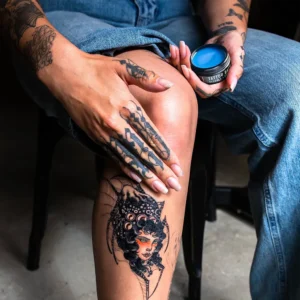
BOOK YOUR APPOINTMENT NOW!
- Shop 62, Brisa Residency Complex, Naika vaddo, Bardez, Calangute Candolim Sinquerim Rd, Calangute, Goa - 403516
- info@sandytattoo.com
- +91 95526 66999
The Art of Tattoo Fixes: Common Reasons and Maintenance Tips

INTRODUCTION
Tattoos are a method of communicating something about the self that is permanent, artistic, and personal; it is an outward representation of an inward emotion, principle, or interest. Still, like every other artwork, tattoos sometimes require adjustments to be made. Some people get tattoo removals because their tattoos naturally faded, some had a bad tattooist and others simply got tired of the design, inevitably, tattoo corrections are important and this blog tries to explain why, how, and when people will need to get their tattoos fixed.
Common Reasons for Tattoo Fixes
- Fading
In general tattoo art may corrode owing to different reasons including sun exposure, the texture of the skin, and the kind of ink applied. Blurring is yet another process that can reduce the brightness of a tattoo and make it seem uninteresting.
- Blowouts
Tattoo blowouts happen when the ink diffuses beneath the epidermis and creates a blurry or blurred image. This is sometimes the case when the tattoo artist applies the ink to the skin at the wrong or deep angle.
- Design Flaws
It may sometimes happen that the chosen image that a client wants to be depicted on his skin may seem different during the process of tattooing. This may be because it may have lacked detail, it may have been poorly implemented, or people just got bored with this design.
- Aging and Skin Changes
Skin undergoes some changes with age and loses its elasticity coupled with signs such as wrinkling or sagging skin. These changes can also distort the tattoo and it may look different from how it was done in the first instance.
- Infections and Scarring
Microbial infections, especially when a wound is in the process of healing, may result in contracture, and hence change the appearance of the tattoo. This problem is associated with poor aftercare or unhygienic conditions in which the tattooing occurred.
- Outdated Style
Styles that used to be popular are replaced with new styles. Popular culture from one decade may seem to be archaic in the subsequent decade. People also may find that what they like has been altered, and they would prefer to alter or remove the tattoo in question.
Methods of Tattoo Fixes
- Touch-Ups
Tattoo retouching means that the tattooist will work again over your tattoo to make the color and the edges of the tattoo sharper. This is the least severe of a tattoo correction and it is advised to keep the tattoo in excellent condition.
- Cover-Ups
Masking involves designing a new tattoo to conceal a former tattoo that is not desirable or wanted by the tattoo wearer anymore. This is more helpful to those who would wish to remove unsightly and unsuitable tattoos or those who can not be corrected by cover-ups.
- Laser Removal and Redo
For more serious cases or when minor touch-ups are not enough, then laser treatment is utilized to fade or erase the tattoo. The new tattoo can be done when the skin is healed. This process takes a longer time and can be costly but is friendly to the artist by offering a clean surface to create new masterpieces.
- Reworking and Re-inking
Reworking includes the incorporation of extra pieces or new details into the original art of the tattoo. This can improve the general aspect of the body art and revitalize a tattoo that has somehow faded in interest to the bearer.
- Adding White Ink Highlights
White ink can help create highlights and finer lines that make the tattoo pop from the skin. This can make a huge difference, especially in black and grey tattoos since it takes slightly longer to cover up all the darker shades.
Maintaining the Quality and Appearance of Your Tattoo
- Proper Aftercare
– Keep it Clean: Consequently, one should follow the aftercare initially recommended by the tattoo artist which usually includes gentle washing with soap and water.
– Moisturize: To treat the tattooed area, one ought to use the recommended ointment or moisturizer to help in the healing process.
– Avoid Picking and Scratching: Finally, it allows scabs and peeling skin to heal on its own to minimize the possibility of having scars.
- Sun Protection
– Use Sunscreen: When going to a sunlit place, ensure you put on a high SPF sunscreen on your tattooed area. They also assessed that UV rays are capable of causing important fading.
– Cover-Up: Sunlight is another factor that can harm your tattoo: avoid direct sun exposure by wearing protective clothing during the daytime, especially in the hottest hours.
- Healthy Lifestyle
– Stay Hydrated: Staying properly hydrated will also keep your skin looking good meaning your tattoo will also look vibrant.
– Eat a Balanced Diet: A combination of vitamins and minerals that are taken in through the foods that one takes will help in the improvement of the skin.
– Avoid Smoking: Smoking causes skin to lose its flexibility and dehydrates it, which can lead to premature aging of the skin which will affect the texture and vibrancy of a tattoo.
- Regular Touch-Ups
– You must visit your tattooist for a touch-up at least once in a few weeks to keep your tattoo looking as if it was newly done. It will vary according to the location of the tattoo, the condition of your skin, exposure, etc.
- Avoid Harsh Chemicals
– Do not use chemicals and acne creams containing alcohol or scrubs that may destroy skin cells necessary to help establish the tattoo.
- Maintain a Stable Weight
Sudden weight changes such as gain or loss can cause the skin to become tight and this may lead to a change in the shape of the tattooed area. Proper weight management will also ensure that the skin remains firm hence preserving the appearance of the tattoo.
FAQ
- How long should I wait before getting a touch-up on a new tattoo?
Remember that it will take 4-6 weeks for the tattooed skin to fully heal, so wait for that period before going for a touch-up.
- Can any tattoo be covered up with a new design?
Almost all tattoos can be camouflaged, although the result highly depends on the size, color, and the density of the primary tattooing
- Will my tattoo hurt more during a touch-up or rework?
It usually takes the same amount of pain as getting a new tattoo in touch-ups or reworks, it might even hurt less if the area is healed already.
- How often should I apply sunscreen to my tattoo?
Sunscreen should be used every time the wearer is under the sun to prevent the colors from fading or getting damaged.
- Can I use a regular moisturizer on my tattoo?
Yes, but be sure to pick one that has no scent and no ingredients that might cause an allergic reaction on the skin.
Conclusion
Tattoos are for a lifetime so like any other valuable asset, it is wise to take good care of it occasionally and have it modified or cleaned where necessary. It is necessary to realize why tattoo correction is necessary and the ways to solve these problems, to maintain the tattoo look perfect. Here is some advice on how to take care of your tattoos after getting them to keep them looking good for as long as possible. Whether it is a touch-up, a redo, or plain care, the right actions can go a long way in maintaining the masterpiece inscribed on your skin.
is proudly powered by WordPress
